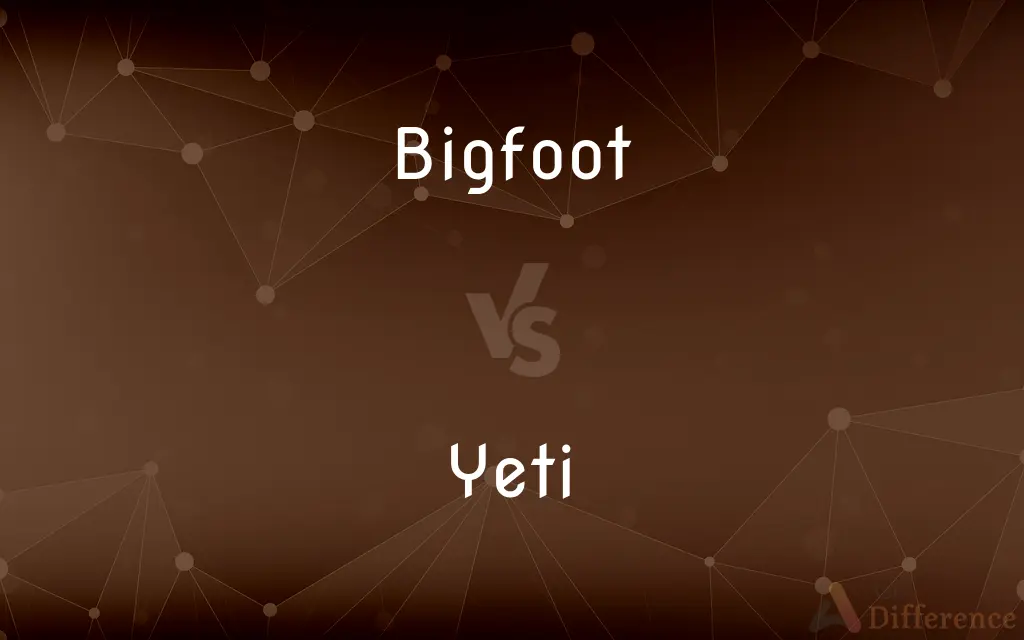Bigfoot vs. Yeti — What's the Difference?
By Urooj Arif & Maham Liaqat — Updated on April 26, 2024
Bigfoot, often reported in North America, is described as a large, hairy ape-like creature, while the Yeti, associated with the Himalayas, is similarly shrouded in mystery but depicted as more bear-like.

Difference Between Bigfoot and Yeti
Table of Contents
ADVERTISEMENT
Key Differences
Bigfoot, a folklore legend predominantly from the forests of North America, is often depicted as a shy, elusive creature. On the other hand, the Yeti, or "Abominable Snowman," is rooted in the traditions of the Himalayan regions of Nepal and Tibet, surrounded by tales of a formidable and solitary beast.
Bigfoot sightings typically describe a creature standing up to 10 feet tall with a strong, foul odor. Whereas the Yeti is usually portrayed as slightly smaller, with a dense, white coat helping it blend into the snowy environment.
Both creatures are central to cryptozoology, yet Bigfoot is more frequently featured in American media and popular culture, inspiring films, books, and scientific expeditions. In contrast, the Yeti remains more enigmatic, with its lore deeply intertwined with Sherpa culture and often treated with a certain reverence.
Eyewitness accounts of Bigfoot often report a figure with large, glowing eyes and a human-like face. Meanwhile, Yeti descriptions tend to emphasize its more rugged, wild features, and an almost bear-like face.
Footprints believed to belong to Bigfoot are often massive with distinctive toe shapes, contributing to the creature’s mystique. Conversely, Yeti tracks are sometimes found in snow and are equally mysterious but are often attributed to known wildlife by skeptics.
ADVERTISEMENT
Comparison Chart
Region
North America
Himalayas (Nepal, Tibet)
Appearance
Large, hairy, ape-like
Bear-like, often white-coated
Cultural Impact
High in American media
Deeply embedded in local lore
Descriptions
Up to 10 feet tall, foul odor
Smaller, rugged, wild features
Evidence
Footprints, eyewitness accounts
Footprints, limited photographic proof
Compare with Definitions
Bigfoot
A legendary North American creature reputed for its large size and shrouded in mystery.
People often claim to see Bigfoot in the remote forests of the Pacific Northwest.
Yeti
A mythical creature from the Himalayan folklore, often called the "Abominable Snowman".
Mountaineers have occasionally reported Yeti sightings in the Himalayas.
Bigfoot
A popular figure in folklore and cryptozoology.
Bigfoot enthusiasts gather annually to share stories and evidence.
Yeti
Regarded with a mixture of fear and reverence in local cultures.
Yeti is considered a protector of the mountains to some Sherpa communities.
Bigfoot
Often described as having a foul smell and glowing eyes.
Witnesses frequently recount the intense odor associated with a Bigfoot sighting.
Yeti
The focus of various scientific investigations and hoaxes.
Expeditions have been mounted to find evidence of the Yeti's existence.
Bigfoot
The subject of various scientific and pseudoscientific studies.
Researchers use night vision cameras to potentially capture Bigfoot on film.
Yeti
Occasionally appears in global popular culture, reflecting its mysterious nature.
The Yeti is featured in adventure stories and novels.
Bigfoot
Featured in numerous documentaries and movies.
The film portrayed Bigfoot as a misunderstood creature.
Yeti
Typically depicted as having white fur, helping it camouflage in snowy surroundings.
Yeti tracks were found in the snow, leading some to believe in its presence.
Bigfoot
Bigfoot, also commonly referred to as Sasquatch, in Canadian and American folklore, is an ape-like creature that is purported to inhabit the forests of North America. Supposed evidence of the existence of Bigfoot includes a number of anecdotal visual sightings, disputed video and audio recordings, photographs, and casts of large footprints.
Yeti
The Yeti (), also known as Meh-Teh in Himalayan folklore, is an ape-like creature purported to inhabit the Himalayan mountain range in Asia. In western popular culture, the creature is commonly referred to as the Abominable Snowman.
Bigfoot
A very large, hairy, humanlike creature purported to inhabit the Pacific Northwest and Canada. Also called Sasquatch.
Yeti
A hairy humanlike animal purported to inhabit the snows of the high Himalaya Mountains. Also called abominable snowman.
Bigfoot
To control or manage forcefully; to exercise authority over.
Yeti
(cryptozoology) An unidentified humanoid animal said to live in the Himalayas.
Bigfoot
To behave in an authoritative, commanding manner.
Yeti
Large hairy humanoid creature said to live in the Himalayas
Bigfoot
Large hairy humanoid creature said to live in wilderness areas of the United States and Canada
Common Curiosities
Where are most Bigfoot sightings reported?
Most Bigfoot sightings are reported in the Pacific Northwest of the United States and Canada.
Are there any physical evidences of Bigfoot?
Physical evidence of Bigfoot includes footprints, hair samples, and occasionally photographs, though none have been conclusively verified.
What is the Yeti?
The Yeti, or Abominable Snowman, is a mythical beast from Himalayan folklore, often depicted as bear-like and covered in white fur.
How does Yeti differ from Bigfoot in physical appearance?
The Yeti is often described as bear-like with white fur to blend into its snowy environment, unlike Bigfoot’s more ape-like, dark-haired appearance.
What role does the Yeti play in local cultures?
In Himalayan regions, the Yeti is part of folklore and is sometimes seen as a guardian of the mountains.
How do scientists view Bigfoot and Yeti claims?
Most scientists are skeptical of Bigfoot and Yeti claims, categorizing them as part of cryptozoology rather than legitimate zoology.
What is Bigfoot?
Bigfoot is a legendary creature said to inhabit North American forests, often described as a large, hairy, ape-like being.
How do local legends affect the perception of these creatures?
Local legends significantly shape the perception of Bigfoot and Yeti, often attributing supernatural qualities to them.
How has Bigfoot influenced American culture?
Bigfoot has a significant cultural impact in America, inspiring movies, books, and numerous TV shows.
What kind of evidence supports the existence of the Yeti?
Evidence supporting the existence of the Yeti includes anecdotal accounts, footprints, and occasionally blurry photographs.
How are new sightings of Bigfoot and Yeti reported and examined?
New sightings are typically reported through local media and investigated by enthusiasts and sometimes scientists, though often with skepticism.
What typical features are reported in Yeti sightings?
Yeti sightings typically include descriptions of large footprints in the snow, a hulking figure, and sometimes a frightening roar.
Are there any significant differences in the footprints of Bigfoot and Yeti?
Bigfoot footprints are generally larger and show distinct toes, unlike the more ambiguous and varied footprints associated with Yeti.
Has Bigfoot ever been captured on film?
There are several films claimed to show Bigfoot, most notably the Patterson-Gimlin film of 1967, though its authenticity is debated.
Do Bigfoot and Yeti belong to the same species?
While both are legendary creatures, they are culturally distinct and not scientifically recognized as real species.
Share Your Discovery

Previous Comparison
Mistress vs. Mister
Next Comparison
Theory vs. ApproachAuthor Spotlight
Written by
Urooj ArifUrooj is a skilled content writer at Ask Difference, known for her exceptional ability to simplify complex topics into engaging and informative content. With a passion for research and a flair for clear, concise writing, she consistently delivers articles that resonate with our diverse audience.
Co-written by
Maham Liaqat















































